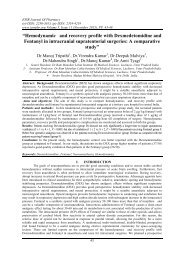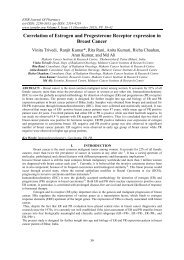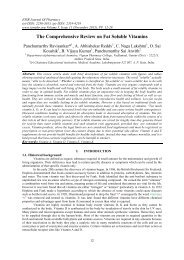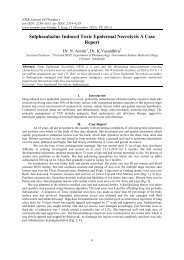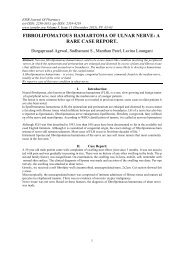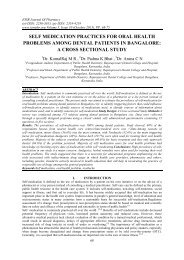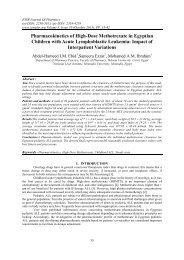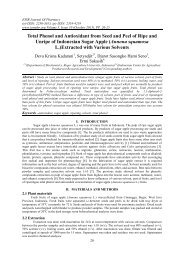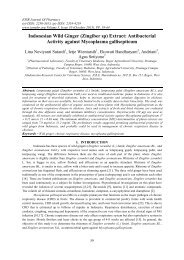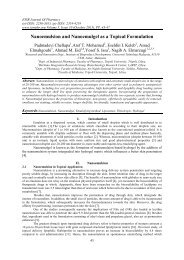Complete NMR Assignment of MogrosidesII A2, II E andIII A1Isolated from Luo Han Guo
NMR analysis allowed complete assignments of three known mogrol glycosides, Mogroside IIA2 (1), II E (2)and IIIA1 (3), isolated from the extracts of Luo Han Guo. Herein, complete 1H and 13C NMR assignmentsof all threemogrosidesare described based on NMR experiments (1H NMR, 13C NMR, COSY, HSQC-DEPT, HMBC, NOESY and 1DTOCSY) and mass spectral data.
NMR analysis allowed complete assignments of three known mogrol glycosides, Mogroside IIA2 (1), II E (2)and IIIA1 (3), isolated from the extracts of Luo Han Guo. Herein, complete 1H and 13C NMR assignmentsof all threemogrosidesare described based on NMR experiments (1H NMR, 13C NMR, COSY, HSQC-DEPT, HMBC, NOESY and 1DTOCSY) and mass spectral data.
You also want an ePaper? Increase the reach of your titles
YUMPU automatically turns print PDFs into web optimized ePapers that Google loves.
<strong>Complete</strong> <strong>NMR</strong> <strong>Assignment</strong> <strong>of</strong> <strong>Mogrosides<strong>II</strong></strong>…<br />
<strong>II</strong>. Materials and Methods<br />
The material used for the isolation <strong>of</strong> Mogroside <strong>II</strong>A 2 , <strong>II</strong> E and <strong>II</strong>IA 1 was <strong>Luo</strong> <strong>Han</strong> <strong>Guo</strong> extract (10 g) purchased<br />
<strong>from</strong> Chengdu Biopurify Phytochemicals, China.<br />
General Methods<br />
<strong>NMR</strong> sampleswerepreparedin CD 3 OD (~1.4-2 mg/130-150 µL) and <strong>NMR</strong> data were acquired on BrukerAvance<br />
500 MHz instruments with either a 2.5 mm inverse probe or a 5 mm broad band probe. The 1 H and 13 C <strong>NMR</strong><br />
spectra were referenced to the solvent resonance at H 3.30 ppm and C 49.0 ppm, respectively. MS and MS/MS<br />
data were generated with a Waters QT<strong>of</strong> Micro mass spectrometer equipped with an electrospray ionization<br />
source. The sampleswereanalyzed by negative ESI. The samples (~0.1 mg) werediluted with 50:50<br />
MeCN:H 2 Oeither with or without 0.1% NH 4 OH and introduced via direct infusion.<br />
Isolation and Purification<br />
Primary preparative processing <strong>of</strong> <strong>Luo</strong> <strong>Han</strong> <strong>Guo</strong>extract was performed by purifying on a pre-packed Waters X-<br />
Bridge C-18 column using a Waters Delta Prep LC Model 2000/4000 system(Injection: 1~2 g in 15 mL <strong>of</strong><br />
DMSO and 25 mL <strong>of</strong> water Mobile phase <strong>of</strong> solvent system:0.05% HOAc in water (A), 0.05% HOAc in MeCN<br />
(B) and 0.5% HOAc in MeOH (C);gradient: 90:10:0 (A:B:C, 0-15 min), 50:50:0 (55 min), 0:100:0 (60-70 min)<br />
and then 25:0:75(71-75 min); flow rate:105 mL/min, Detection: UV at 225 nm). Corresponding combined<br />
fractions contained mogrosides were subjected to consecutive secondarypreparative purification processing to<br />
afford Mogrosides <strong>II</strong> A 2 , <strong>II</strong>E and <strong>II</strong>I A 1 .<br />
<strong>II</strong>I. Results and Discussion<br />
Compounds 1, 2 and 3 were isolated as white solids. The ESI-TOF mass spectrum forMogroside <strong>II</strong> A 2 (1)<br />
showed a [M-H] - ion at m/z 799.4817 which upon accurate mass measurement provided the molecular formula<br />
C 42 H 72 O 14 (calcd for C 42 H 71 O 14 : 799.4844, error: -3.4 ppm). Similarly, the ESI-TOF mass spectrum acquired for<br />
Mogroside <strong>II</strong> E (2) showed a [M-H] - ion at 799.4738 which also corresponded to the molecular formula<br />
C 42 H 72 O 14 (calcd for C 42 H 71 O 14 : 799.4844, error: -1.6 ppm) indicative <strong>of</strong> compounds1 and 2being isomers. For<br />
Mogroside <strong>II</strong>I A 1 (3), ESI-TOF mass spectrum showed a [M-H] - ion at m/z 961.5316 and accurate mass<br />
measurement provided the molecular formula C 48 H 82 O 19 (calcd for C 48 H 81 O 19 : 961.5372, error: -5.8 ppm).<br />
The 1D and 2D <strong>NMR</strong> data showed that theMogrosides <strong>II</strong> A 2 (1), <strong>II</strong> E (2) and <strong>II</strong>I A 1 (3) share the same<br />
triterpenecentral core with seven methyl singletsbetween 0.86 – 1.18, a methyl doublet between 0.96 – 0.97,<br />
eight methylenes between 1.13 – 2.42, fourmethine protons between 1.45 – 2.50, three additional methines<br />
between 3.21-3.85, the chemical shifts indicative <strong>of</strong> these methines being attached to carbons bearing oxygen<br />
groups, and a tertiary hydroxyl carbon between c 73.6 – 73.9. The three compounds vary by the substituents <strong>of</strong><br />
secondary alcohols at C-3 and C-24 in the Mogroside core. The triterpenoidaglycone central core for compound<br />
1 was supported by 1 H- 1 H COSY correlations <strong>of</strong> H-1/H-2; H-2/H-3; H-6/H-7; H-7/H-8; H-10/H-1; H-11/H-12;<br />
H-15/H-16; H-16/H-17; H-17/H-20; H-20/H-21; H-20/H-22; H-22/H-23 and H-23/H-24 and 1 H- 13 C HMBC<br />
correlations <strong>of</strong> H-6/C-4, C-8; H-8/C-6, C-14; H-11/C-9, C-10, C-19; H-18/C-12, C-13, C-14, C-17; H-19/C-8,<br />
C-9, C-10; H-21/C-17, C-20, C-22; H-24/C-23, C-25; H-26 and H-27/C-24, C-25; H-28 and H-29/C-3, C-4, C-5<br />
and H-30/C-8, C-13, C-14, C-15.The key 1 H- 1 H COSY and 1 H- 13 C HMBC correlations used to assign the<br />
aglycone unit <strong>of</strong> 1 are provided in Figure 2 (A).The COSY and HMBC correlations observed for compounds 2<br />
and 3 were consistent with compound 1. The complete 1 H and 13 C <strong>NMR</strong> assignments<strong>of</strong> the aglycones <strong>of</strong> all three<br />
compounds were madeon the basis <strong>of</strong> 1 H, 13 C,COSY, HSQC-DEPTand HMBC dataand aregiven in Table 1.<br />
The relative stereochemistry <strong>of</strong> the central triterpene core was assigned based on NOE correlations. In the<br />
NOESY spectrum <strong>of</strong> 1, NOE correlations <strong>of</strong> H-10/H-28, H-10/H-30 and H-30/H-17 indicated that H-10, H-17,<br />
H-28, and H-30 are on the same face <strong>of</strong> the rings. Similarly, NOE correlations <strong>of</strong>H-8/H-18, H-8/H-19, H-11/ H-<br />
18, H-11/H-19 indicated that H-8, H-11, H-18 and H-19 are on the same face <strong>of</strong> the ring.Absence <strong>of</strong> NOE<br />
correlations between H-8/H-11/H-18/H-19 and H-10/H-17/H-28/H-30 indicated that these were on the opposite<br />
face <strong>of</strong> the rings as presented in Figure 2. Also, NOE correlations observed between H-17 and H-21 indicated<br />
that they are on the same face. Based on the available NOESY data, the relative stereochemistry <strong>of</strong> H-3 and H-<br />
29 could not be assigned unambiguously. However, based on large coupling constant (7.8 Hz, β-configuration)<br />
<strong>of</strong> Glc IV anomeric proton and its attachment at C-3 <strong>of</strong> the central triterpene core (discussed below), the H-3<br />
would most likely be in α-orientation. Also, since the relative stereochemistry <strong>of</strong>H-28 is assigned as α, the<br />
relative stereochemistry <strong>of</strong>H-29 would be β as shown in figure 2.The relative stereochemistry for the central<br />
triterpene core <strong>of</strong> compounds2 and 3 were similarly assigned are consistent with Mogroside <strong>II</strong> A 2 (1) (Figure 2).<br />
49




